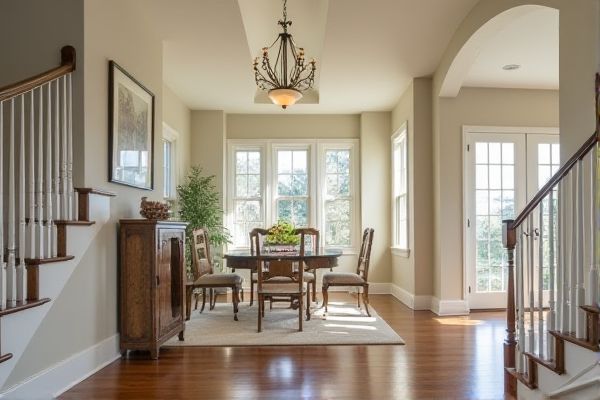
Vertical balusters provide a classic, traditional look and offer enhanced safety by preventing climbing, while horizontal balusters create a modern aesthetic but may require additional safety measures. Discover which baluster style best complements your space and meets your needs by exploring the rest of the article.
Table of Comparison
| Feature | Vertical Balusters | Horizontal Balusters |
|---|---|---|
| Design Style | Traditional, classic look | Modern, contemporary appeal |
| Safety | Meets most building codes easily | May require additional safety measures |
| Installation | Simple and straightforward | More complex and time-consuming |
| Maintenance | Easy to clean and maintain | Potential for more dirt and dust buildup |
| Visibility | Less horizontal sightlines, more privacy | Open visibility, enhances openness |
| Material Options | Wood, metal, vinyl common | Metal and wood preferred for strength |
| Cost | Generally lower cost | Often higher cost due to complexity |
Introduction to Vertical and Horizontal Balusters
Vertical balusters offer traditional, timeless support for stair railings, enhancing safety while ensuring an open, airy feel. Horizontal balusters provide a modern, sleek aesthetic with a streamlined design, ideal for contemporary spaces seeking bold visual lines. You can choose between these styles based on your architectural preference, desired ambiance, and local building codes.
Defining Vertical Balusters
Vertical balusters are upright, evenly spaced supports commonly used in stair railings and balcony guards to provide safety and structural integrity. They enhance visual height and create a traditional, classic aesthetic in architectural designs while effectively preventing falls. Typically made from materials such as wood, metal, or glass, vertical balusters contribute to both the safety and style of indoor and outdoor spaces.
Understanding Horizontal Balusters
Horizontal balusters offer a sleek, modern aesthetic by running parallel to the staircase, creating an open and airy feel that enhances visibility and light flow. They are typically constructed from metal or wood and require secure anchoring to maintain safety and structural integrity, especially in residential or commercial staircases. Understanding horizontal balusters involves recognizing their effectiveness in contemporary designs while ensuring compliance with building codes related to spacing and strength for user safety.
Aesthetic Differences: Vertical vs Horizontal Balusters
Vertical balusters create a traditional, classic aesthetic with a sense of height and openness, often complementing various architectural styles from colonial to contemporary. Horizontal balusters offer a modern, sleek appearance that emphasizes clean lines and a more expansive, streamlined look ideal for minimalist and industrial designs. The choice impacts not only visual perception but also the overall style cohesion of staircases and balconies in residential or commercial spaces.
Safety Considerations for Residential Spaces
Vertical balusters offer enhanced safety in residential spaces by preventing children from climbing, as their design limits footholds and handholds. Horizontal balusters, while aesthetically modern, may pose risks by creating a ladder effect, increasing the chance of falls. You should prioritize vertical balusters to ensure compliance with safety codes and protect your family effectively.
Building Code Compliance and Regulations
Vertical balusters meet most international building codes by maintaining consistent spacing that prevents small children from slipping through, typically not exceeding 4 inches between balusters. Horizontal balusters often face stricter scrutiny or are prohibited in some jurisdictions due to climbing hazards, raising safety concerns that influence regulatory compliance. Compliance with local codes requires verifying specific regulations for baluster orientation to ensure structural safety and legal conformity in residential and commercial projects.
Installation and Maintenance Factors
Vertical balusters typically offer easier installation due to standardized spacing and simpler alignment with handrails, reducing labor time and complexity. Horizontal balusters may require more precise measurements and secure fastening points to ensure stability, often demanding advanced skills and more frequent checks for loose fittings. You should consider vertical balusters for low-maintenance durability, while horizontal options might need more ongoing care to preserve safety and aesthetic appeal.
Durability and Material Options
Vertical balusters typically offer greater durability due to their load-bearing design, commonly crafted from robust materials like wrought iron, steel, and hardwood, which resist bending and warping over time. Horizontal balusters, often made from aluminum, stainless steel cables, or composite materials, provide modern aesthetics but may require more maintenance to prevent sagging and corrosion, especially in outdoor environments. Choosing between vertical and horizontal balusters depends on both the material's strength and environmental exposure, with vertical styles generally favored for long-lasting structural integrity.
Cost Comparison: Vertical vs Horizontal Designs
Vertical balusters typically cost less than horizontal balusters due to simpler manufacturing and installation processes. Horizontal balusters require more precise engineering and additional supports, increasing material and labor expenses. Choosing vertical designs can result in a 15-25% reduction in overall baluster costs compared to horizontal alternatives.
Choosing the Right Baluster Style for Your Home
Vertical balusters offer a classic, timeless look that enhances traditional and modern architectural styles while providing added safety and structural support. Horizontal balusters create a sleek, contemporary aesthetic ideal for minimalist or industrial designs, but may require additional spacing considerations to meet building codes. Selecting the right baluster style depends on your home's design, safety needs, and local regulations to achieve both visual appeal and functionality.
 homyna.com
homyna.com